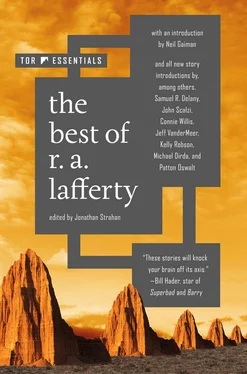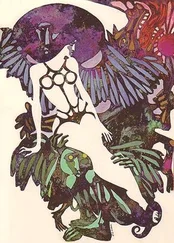A high point of the drama is the duel of the locomotives that takes place during a tempestuous night in the West Orange Switching Yards. Again and again, Patience Palmer is all but trapped on railroad trestles by thundering locomotives driven by her adversaries (the West Orange Switching Yards seem to consist almost entirely of very high railroad trestles). Patience finally gets control of a locomotive of her own on which to escape, but the locomotives of her enemies thunder at her from every direction so that she is able to switch out of their way only at the last brink of every moment.
The Embalmer attempts to stab her with his needleful of embalming fluid every time their locomotives pass each other with double thunder and only inches to spare. The Whip tries to lash her with his cruel lash with its poisoned tip; and the Slaver threatens her with the outreached forged certificate of color, and only by fantastic cringing can she cringe back far enough to keep from being touched by it as their locomotives roar past each other in opposite directions.
It seems impossible that the racing locomotives can come so close and not hit each other, with their dazzling switching from track to track. And then (Oh, God save us all!) the Panther (Is he a Man? Is he a Devil?) has leaped from his own locomotive to that of Patience Palmer: he is behind her on her own locomotive, and she does not see him . He comes closer—but the climax of The Perils of Patience is not there in the West Orange Switching Yards. It is at a secret town and castle in the Barrens of New Jersey, a castle of evil repute. In this place the enemies of Patience were assembling a gang of beaters (slack-faced fellows with their tongues cut out), and they were readying bloodhounds to hunt Patience down to her death. She somehow obtains a large wagon piled high with hay and pulled by six large high-spirited horses. With this, she boldly drives, on a stormy night, into the secret town of her enemies and down that jagged road (there was a lightning storm going on that made everything seem jagged) at the end of which was the castle itself. The bloodhounds leap high at her as she passes, but they cannot pull her from the wagon.
But the Panther (Is he a Man? Is he a Beast?) has leaped onto her hay wagon behind her, and she does not see him . He comes close behind her—but Patience Palmer is already making her move. Driving unswervingly, carrying out her own intrepid plan, at that very moment she raises a key in her hand very high into the air. This draws the lightning down with a stunning flash, and the hay wagon is set ablaze. Patience leaps clear of the flaming hay wagon at the last possible moment, and the blazing, hurtling inferno crashes into the tall and evil castle to set it and its outbuildings and its whole town ablaze.
This is the flaming climax to one of the greatest chase dramas ever.
This final scene of The Perils will be met with often later. Due to the character of the “slow light” or selenium scenes, this vivid scene leaks out of its own framework and is superimposed, sometimes faintly, sometimes powerfully, as a ghost scene on all twelve of the subsequent dramas.
2. Thirsty Daggers, a Murder Mystery . This is the second of the Aurelian Bentley television dramas of 1873. Clarinda Calliope, one of the most talented actresses of her time, played the part of Maud Trenchant, the Girl Detective. The actors Leslie Whitemansion, Kirbac Fouet, X. Paul McCoffin, Jaime del Diablo, Torres Malgre, Inspiro Spectralski, and Hubert Saint Nicholas played powerful and menacing roles, but their identities and purposes cannot be set exactly. One must enter into the bloody and thrilling spirit of the drama without knowing the details.
More even than The Perils of Patience does Thirsty Daggers seem to be freed from the bonds of time and sequence. It is all one unfolding moment, growing always in intensity and intricacy, but not following a straight line of action. And this, accompanied by a deficiency of the libretto, leads to confusion.
The libretto cannot be read. It is darkened and stained. Chemical analysis has revealed that it is stained with human blood. It is our belief that Bentley sent the librettos to his clients decorated with fresh human blood to set a mood. But time has spread the stains, and almost nothing can be read. This is, however, a highly interesting drama, the earliest murder ever done for television.
It is nearly certain that Maud Trenchant, the Girl Detective, overcomes all the menaces and solves all the crimes, but the finer details of this are lost forever.
3. The Great Bicycle Race, the third of the Bentley television dramas, has that versatile actress Clarinda Calliope playing the lead role of July Meadowbloom in this joyful and allegorical “journey into summertime.” It is in The Great Bicycle Race that sound makes its first appearance in the Bentley dramas. It is the sounds of all outdoors that are heard in this drama, faintly at first, and more and more as time goes on. These are country and village sounds; they are county fair sounds. Though the sounds seem to be an accidental intrusion (another ghostly side-play of the selenium response magic), yet their quality lends belief to the evidence that the full and original title of this drama was The Great Bicycle Race, a Pastoral .
But there are other sounds, sometimes angry, sometimes imploring, sometimes arrogant and menacing—more about them in a bit.
Sheep and cattle sounds are all through the play; goat and horse and swine sounds; the rattle of ducks and geese; all the wonderful noises of the countryside. There are birds and grasshoppers, windmills and wagons, people calling and singing. There are the sounds of carnival barkers and the chants of gamblers and shills. There are the shrieks and giggles of young people.
And then there are those intrusive sounds of another sort, the separate overlay. These seem to be mostly indoor sounds, but sometimes they are outdoor grandstand sounds also, bristling talk in the reserved shadows of crowd noise and roaring.
“No, no, no. I’ll not be had. What sort of a girl do you think I am?”
“All these things I will give you, Clarie. No one else would give you so much. No one else would ever care so much. But now is the time for it. Now is the summer of our lives. Now we cut hay.”
“Let’s just see the price of a good hay barn first, Aurie. Let’s just get some things down on paper right now. We are talking about a summertime check that is as big as all summer. And we are talking about a much larger settlement to back up the other seasons and years.”
“Don’t you trust me, Clarie?”
“Of course I trust you, Bentley baby. I trust that you will get that trust fund that we are talking about down on paper today. I am a very trusting woman. I believe that we should have a trust fund to cover every condition and circumstance.”
Odd talk that, to be mixed in with the sound of The Great Bicycle Race .
The race was in conjunction with the Tri-county Fair, which counties were Camden, Gloucester, and Atlantic. The bicycle racers rode their twenty-mile course every afternoon for five afternoons, and careful time was kept. There was betting on each day’s race, but there was bigger betting on the final winner with the lowest total time for the five days, and the kitty grew and grew. From the great fairground grandstand, one could see almost all of the twenty-mile course that the riders rode, or could follow it by the plumes of dust. The grandstand was on high ground and the whole countryside was spread out before it. Cattle and mules were paraded and judged in front of that grandstand, before and during and after that daily race; then the race (for the approximate hour that it took to run it) was the big thing. There were seven drivers in the race, and all of them were world famous:
Читать дальше




![Рафаэль Лафферти - Дни, полные любви и смерти. Лучшее [сборник litres]](/books/385123/rafael-lafferti-dni-polnye-lyubvi-i-smerti-luchshe-thumb.webp)
![Рафаэль Лафферти - Лучшее [Сборник фантастических рассказов]](/books/401500/rafael-lafferti-luchshee-sbornik-fantasticheskih-ra-thumb.webp)